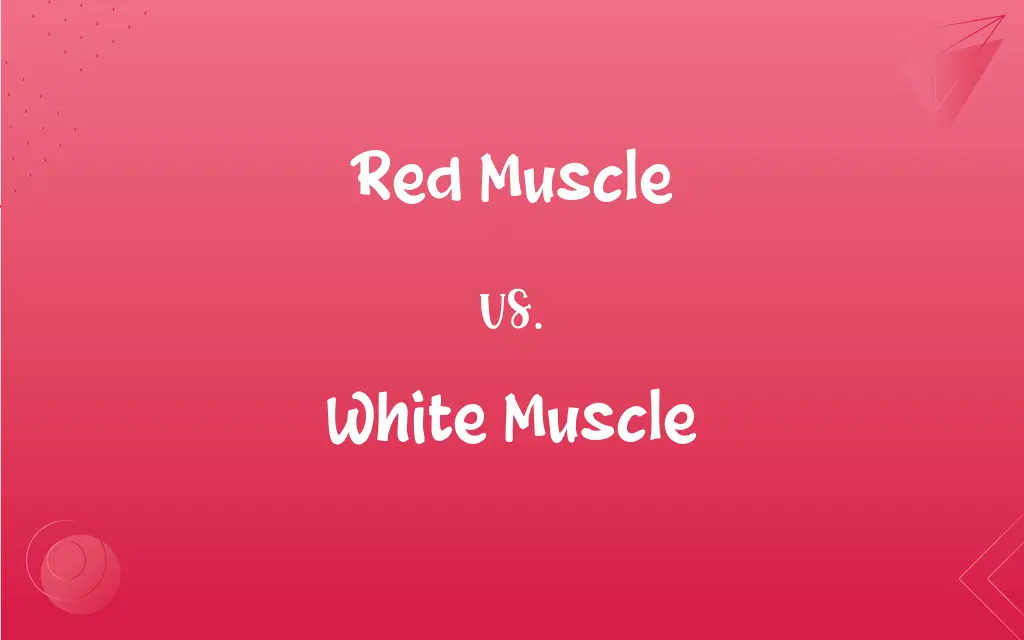Red Muscle vs. White Muscle: What's the Difference?
Edited by Janet White || By Harlon Moss || Updated on October 5, 2023
Red muscle fibers are dense with capillaries and mitochondria, enabling sustained, oxygen-using (aerobic) activity. White muscle fibers are less dense in capillaries and mitochondria, facilitating short bursts of powerful, anaerobic activity.

Key Differences
Red muscle fibers are known for their endurance and are densely packed with mitochondria and blood capillaries, which grants them their distinctive red color. On the contrary, white muscle fibers contain fewer mitochondria and capillaries, resulting in a paler appearance. These stark differences in structure significantly impact the performance and utilization of these muscle fibers in various physical activities.
When examining red muscle, the presence of myoglobin, a protein that binds oxygen, is notable and aids in sustaining prolonged, less intense activities like distance running. White muscle, lacking in myoglobin, demonstrates its prowess in short, rapid, and high-intensity activities such as sprinting, where quick contractions are pivotal.
Red muscle fibers predominantly generate energy through aerobic respiration, utilizing oxygen to produce adenosine triphosphate (ATP), essential for muscle contraction. In contrast, white muscle fibers predominantly depend on anaerobic respiration for energy production, rapidly generating power but fatiguing quickly.
Fatigue resistance characterizes red muscle due to its capability to efficiently utilize oxygen in energy production, making it vital for maintaining posture and other continuous, low-intensity activities. Inversely, white muscle is prone to quick fatigue, given its reliance on energy reserves, which are limited and deplete rapidly during intense exertion.
Considering diseases, red muscle is less susceptible to fatigue and conditions related to endurance activities. Meanwhile, white muscle might be more susceptible to conditions that affect power generation and rapid energy utilization, given its structural and functional characteristics.
ADVERTISEMENT
Comparison Chart
Color
Red due to abundant myoglobin.
White due to less myoglobin.
Energy Production
Primarily through aerobic pathways.
Primarily through anaerobic pathways.
Endurance
High endurance and fatigue-resistant.
Low endurance, fatigues quickly.
Myoglobin Content
High, supporting sustained activity.
Low, supporting brief, intense activity.
Usage Example
Used in long-distance running.
Used in sprinting and jumping.
ADVERTISEMENT
Red Muscle and White Muscle Definitions
Red Muscle
Red muscle emphasizes aerobic metabolism, utilizing oxygen to generate energy over extended periods.
The red muscle fibers in migrating birds enable them to fly long distances without tiring quickly.
White Muscle
White muscle fibers excel in delivering rapid and powerful contractions, albeit for brief durations.
Sprinters rely heavily on their white muscle fibers to achieve explosive starts in races.
Red Muscle
Red muscle typically appears darker due to its rich vascularization, promoting efficient oxygen transport.
Scientists can identify red muscle in specimens by its distinctive dark hue, indicating abundant blood vessels.
White Muscle
White muscle is paramount in activities that demand brief, high-intensity exertions and power generation.
The white muscle fibers in a cheetah’s legs enable it to achieve remarkable speeds in short bursts.
Red Muscle
Red muscle plays a pivotal role in maintaining posture by facilitating consistent, low-intensity contractions.
The red muscle fibers in our backs continuously contract to keep us upright while standing for extended periods.
White Muscle
White muscle fibers exhibit a pale coloration due to their relatively low myoglobin content.
In a laboratory setting, scientists can differentiate white muscle from red due to its lighter appearance.
Red Muscle
Red muscle fibers are renowned for their high myoglobin and mitochondrial content.
Marathon runners typically have a high proportion of red muscle fibers to support prolonged exertion.
White Muscle
White muscle tends to fatigue quickly due to its dependency on finite, rapidly-depleting energy reserves.
The weightlifter’s white muscle fibers began to fatigue after consecutive, powerful lifts.
Red Muscle
Red muscle is characterized by a notable resistance to fatigue, supporting sustained physical activity.
The abundance of red muscle in a long-distance cyclist’s legs facilitates enduring performance.
White Muscle
White muscle predominantly utilizes anaerobic metabolism, providing quick energy bursts without relying on oxygen.
The white muscle in a frog’s legs allows for quick, forceful jumps to escape predators.
FAQs
Which muscle type contains more mitochondria?
Red muscle contains more mitochondria, supporting prolonged, oxygen-dependent energy production.
Why is white muscle considered “white”?
White muscle appears lighter due to lower myoglobin and fewer capillaries compared to red muscle.
What gives red muscle its color?
The abundant myoglobin and dense capillaries give red muscle its characteristic color.
Can a muscle contain both red and white fibers?
Yes, muscles contain a mix of red and white fibers, with the ratio varying per muscle and individual.
Does a muscle's red and white fiber content influence athletic performance?
Yes, fiber type ratio influences suitability for endurance or power-oriented activities, affecting athletic performance.
In what physical activities is red muscle predominantly engaged?
Red muscle is engaged in activities requiring endurance, like distance running or cycling.
Which muscle type is engaged during powerful, ballistic movements?
White muscle is engaged, providing quick, forceful contractions during ballistic movements.
Are white muscle fibers more prone to fatigue?
Yes, white muscle fibers fatigue quickly due to their reliance on anaerobic energy production.
What is the primary energy production mode for white muscle?
White muscle primarily depends on anaerobic energy production for short, intense activities.
Does red muscle or white muscle have a higher myoglobin content?
Red muscle has higher myoglobin content, aiding in oxygen storage and transport.
Is red muscle more resistant to fatigue than white muscle?
Yes, red muscle’s aerobic metabolism and rich myoglobin content resist rapid fatigue.
Are red muscle fibers typically larger or smaller than white muscle fibers?
Red muscle fibers are typically smaller and have a slower contraction speed compared to white muscle fibers.
How does white muscle contribute to a sprinter’s performance?
White muscle facilitates quick, powerful contractions, crucial for a sprinter's explosive speed.
Which animals might have a higher proportion of white muscle?
Animals requiring quick, powerful movements, like cheetahs or rabbits, have more white muscle.
How does the vascularization of red muscle compare to white muscle?
Red muscle is more densely vascularized, enhancing oxygen transport and endurance.
Why does white muscle fatigue more rapidly than red muscle?
White muscle relies on limited glycogen stores, depleting rapidly during high-intensity efforts.
What role does red muscle play in endurance activities?
Red muscle facilitates sustained activities by utilizing aerobic metabolism for consistent energy.
What roles do white muscle fibers play in anaerobic exercises?
White muscle powers short, intense activities, like lifting or sprinting, through anaerobic metabolism.
Can training influence the performance of red muscle fibers?
Yes, endurance training can enhance red muscle fiber efficiency and aerobic capacity.
How does training impact the function and efficiency of white muscle fibers?
Training, like weight lifting, can enhance white muscle fiber size and anaerobic power output.
About Author
Written by
Harlon MossHarlon is a seasoned quality moderator and accomplished content writer for Difference Wiki. An alumnus of the prestigious University of California, he earned his degree in Computer Science. Leveraging his academic background, Harlon brings a meticulous and informed perspective to his work, ensuring content accuracy and excellence.
Edited by
Janet WhiteJanet White has been an esteemed writer and blogger for Difference Wiki. Holding a Master's degree in Science and Medical Journalism from the prestigious Boston University, she has consistently demonstrated her expertise and passion for her field. When she's not immersed in her work, Janet relishes her time exercising, delving into a good book, and cherishing moments with friends and family.
































































